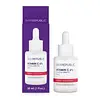What's inside
What's inside
 Key Ingredients
Key Ingredients

 Benefits
Benefits

 Concerns
Concerns

 Ingredients Side-by-side
Ingredients Side-by-side

Water
Skin ConditioningHexyldecanol
EmollientNiacinamide
SmoothingPentylene Glycol
Skin ConditioningGlycerin
HumectantButylene Glycol
HumectantXylitol
HumectantTapioca Starch
Panthenol
Skin ConditioningPhytosteryl/Octyldodecyl Lauroyl Glutamate
Skin ConditioningDimethicone
EmollientBoron Nitride
AbsorbentPolysorbate 20
EmulsifyingTocopheryl Acetate
AntioxidantMica
Cosmetic ColorantAcrylates/C10-30 Alkyl Acrylate Crosspolymer
Emulsion StabilisingInositol
HumectantPhenoxyethanol
PreservativePEG-11 Methyl Ether Dimethicone
EmulsifyingDimethicone/Vinyl Dimethicone Crosspolymer
Skin ConditioningPolyacrylamide
Benzyl Alcohol
PerfumingUndecylenoyl Phenylalanine
Skin ConditioningAminomethyl Propanol
BufferingC13-14 Isoparaffin
EmollientParfum
MaskingDisodium EDTA
Sodium Benzoate
MaskingAscorbyl Glucoside
AntioxidantLaureth-7
EmulsifyingPolymethylsilsesquioxane
Magnesium Aspartate
Skin ConditioningZinc Gluconate
Skin ConditioningCopper Gluconate
Skin ConditioningCI 77891
Cosmetic ColorantCI 19140
Cosmetic ColorantCI 16035
Cosmetic ColorantWater, Hexyldecanol, Niacinamide, Pentylene Glycol, Glycerin, Butylene Glycol, Xylitol, Tapioca Starch, Panthenol, Phytosteryl/Octyldodecyl Lauroyl Glutamate, Dimethicone, Boron Nitride, Polysorbate 20, Tocopheryl Acetate, Mica, Acrylates/C10-30 Alkyl Acrylate Crosspolymer, Inositol, Phenoxyethanol, PEG-11 Methyl Ether Dimethicone, Dimethicone/Vinyl Dimethicone Crosspolymer, Polyacrylamide, Benzyl Alcohol, Undecylenoyl Phenylalanine, Aminomethyl Propanol, C13-14 Isoparaffin, Parfum, Disodium EDTA, Sodium Benzoate, Ascorbyl Glucoside, Laureth-7, Polymethylsilsesquioxane, Magnesium Aspartate, Zinc Gluconate, Copper Gluconate, CI 77891, CI 19140, CI 16035
Ingredients Explained
These ingredients are found in both products.
Ingredients higher up in an ingredient list are typically present in a larger amount.
Niacinamide is a multitasking form of vitamin B3 that strengthens the skin barrier, reduces pores and dark spots, regulates oil, and improves signs of aging.
And the best part? It's gentle and well-tolerated by most skin types, including sensitive and reactive skin.
You might have heard of "niacin flush", or the reddening of skin that causes itchiness. Niacinamide has not been found to cause this.
In very rare cases, some individuals may not be able to tolerate niacinamide at all or experience an allergic reaction to it.
If you are experiencing flaking, irritation, and dryness with this ingredient, be sure to double check all your products as this ingredient can be found in all categories of skincare.
When incorporating niacinamide into your routine, look out for concentration amounts. Typically, 5% niacinamide provides benefits such as fading dark spots. However, if you have sensitive skin, it is better to begin with a smaller concentration.
When you apply niacinamide to your skin, your body converts it into nicotinamide adenine dinucleotide (NAD). NAD is an essential coenzyme that is already found in your cells as "fuel" and powers countless biological processes.
In your skin, NAD helps repair cell damage, produce new healthy cells, support collagen production, strengthen the skin barrier, and fight environmental stressors (like UV and pollution).
Our natural NAD levels start to decline with age, leading to slower skin repair, visible aging, and a weaker skin barrier. By providing your skin niacinamide, you're recharging your skin's NAD levels. This leads to stronger, healthier, and younger looking skin.
Another name for vitamin B3 is nicotinamide. This vitamin is water-soluble and our bodies don't store it. We obtain Vitamin B3 from either food or skincare. Meat, fish, wheat, yeast, and leafy greens contain vitamin B3.
The type of niacinamide used in skincare is synthetically created.
Learn more about Niacinamide